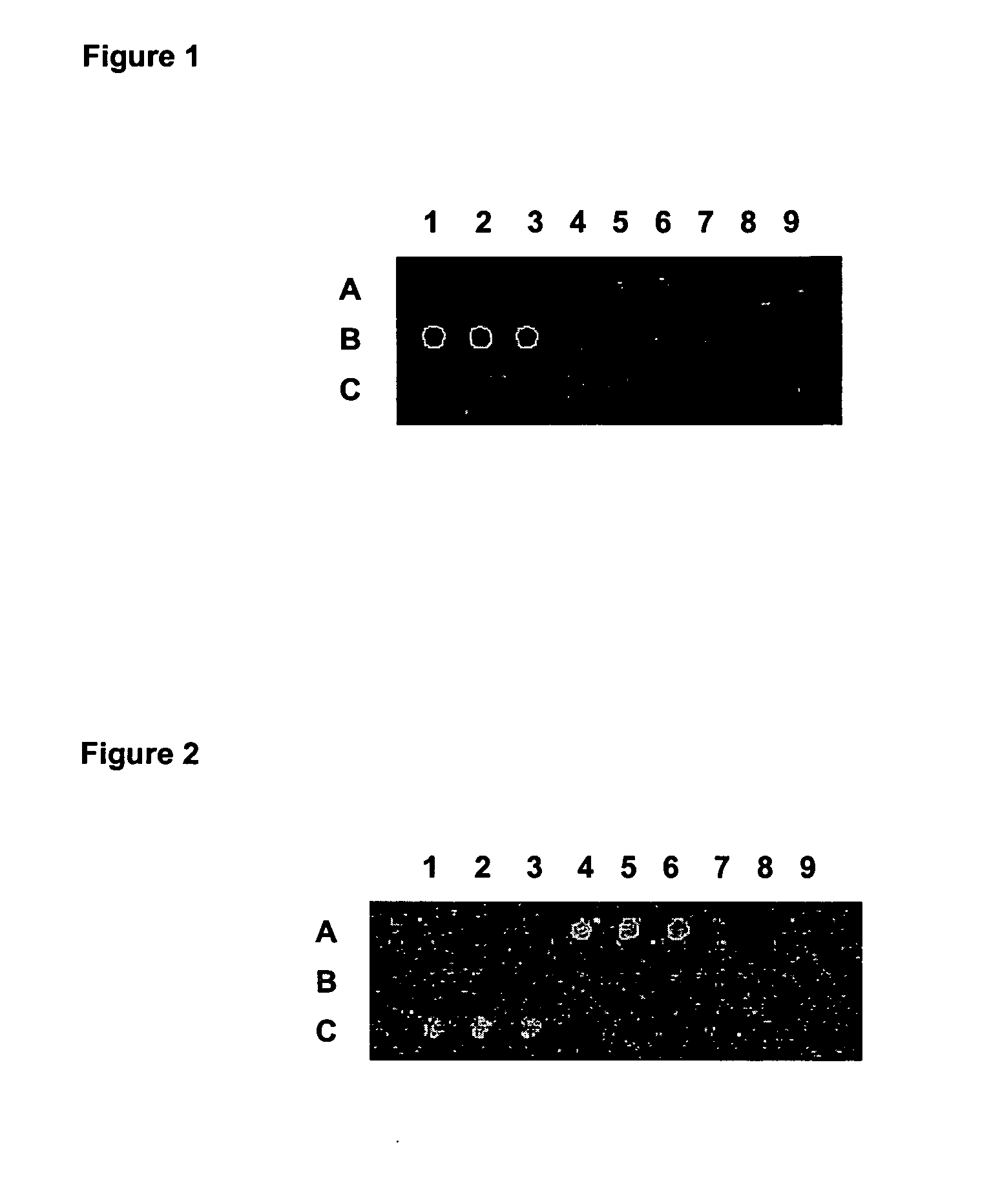Method and array for detection and identification of microorangisms present in a sample using the genomic regions coding for different tRNA synthetases
- Summary
- Abstract
- Description
- Claims
- Application Information
AI Technical Summary
Problems solved by technology
Method used
Image
Examples
example 1
Design of Specific Sequences for 5 Different Microorganisms
[0046] A total of 60 fragments of tRNA-synthases having 100 nucleotides that are specific for species Agrobacterium tumefaciens; Corynebacterium glutamicum; Mycobacterium tuberculosis; Pseudomonas aeruginosa or Xylella fastidiosa were designed. The sequences of all 60 designed tRNA-synthase fragments were included in the list of sequences.
[0047] To design these specific fragments, a database comprising tRNA-synthase sequences for 230 microorganisms selected from NCBI's GenBank public database was first constructed.
[0048] In each case, a set of 100-letter oligonucleotides present in each sequence was determined, discarding those appearing more than once in each sequence, considering up to 3 substitutions. These oligonucleotides were the “candidate oligonucleotides”, which were evaluated according to their thermodynamic stability. Subsequently, thermodynamically favorable fragments were aligned against the entire database, ...
example 2
Microarrays to Detect and Identify the Presence of Microorganisms
[0051] Two microarrays were manufactured with the tRNA-synthase fragments designed in the former example, which specifically identify: Agrobacterium tumefaciens; Corynebacterium glutamicum; Mycobacterium tuberculosis; Pseudomonas aeruginosa or Xylella fastidiosa.
[0052] In each microarray, one 60-nucleotide sub-fragment for each of the designed fragments for each species to be detected, one positive control and three negative controls were included.
[0053] In the first microarray, specific sub-fragments for Agrobacterium tumefaciens; Corynebacterium glutamicum and Mycobacterium tuberculosis were deposited. In the following Table 1, the content of each position in microarray 1 is detailed.
TABLE 1Position in microarray 1MicroorganismtRNA-synthaseAgrobacterium tumefaciensA1-A3Corynebacterium glutamicumB4-B6Mycobacterium tuberculosisC4-C6Positive controlB1-B3Negative controlC1-C3; A4-A6; A7-A9
[0054] Each fragment was de...
example 3
Use of the Obtained Microarrays to Detect and Identify Microorganisms
[0058] The microarrays obtained in Example 2 were used with metagenomic samples obtained from a mixture of commercial strains of each of the species contained in the microarray. Two samples were analyzed, one hybridizing on each microarray, the first one containing a mixture of Agrobacterium tumefaciens, Corynebacterium glutamicum and Mycobacterium tuberculosis (M1), and the second one comprising a mixture of Pseudomonas aeruginosa and Xylella fastidiosa (M2).
[0059] Total DNA was extracted from M1 and M2 using traditional DNA extraction methods.
[0060] 2 μl were taken from the DNA samples, which had a concentration between 1 and 5 μg / μl, and were put in Eppendorf tubes. In each case, the following method was carried out:
[0061] 36 μl of ddH2O and 3.3 ml of 6-nucleotide random primers were added. The mix was boiled for 5 minutes and then the assay was continued on ice.
[0062] 2 μl of a nucleotide mix were added, w...
PUM
| Property | Measurement | Unit |
|---|---|---|
| Stability | aaaaa | aaaaa |
Abstract
Description
Claims
Application Information
 Login to View More
Login to View More - R&D
- Intellectual Property
- Life Sciences
- Materials
- Tech Scout
- Unparalleled Data Quality
- Higher Quality Content
- 60% Fewer Hallucinations
Browse by: Latest US Patents, China's latest patents, Technical Efficacy Thesaurus, Application Domain, Technology Topic, Popular Technical Reports.
© 2025 PatSnap. All rights reserved.Legal|Privacy policy|Modern Slavery Act Transparency Statement|Sitemap|About US| Contact US: help@patsnap.com

